Photos by Tom Lynch
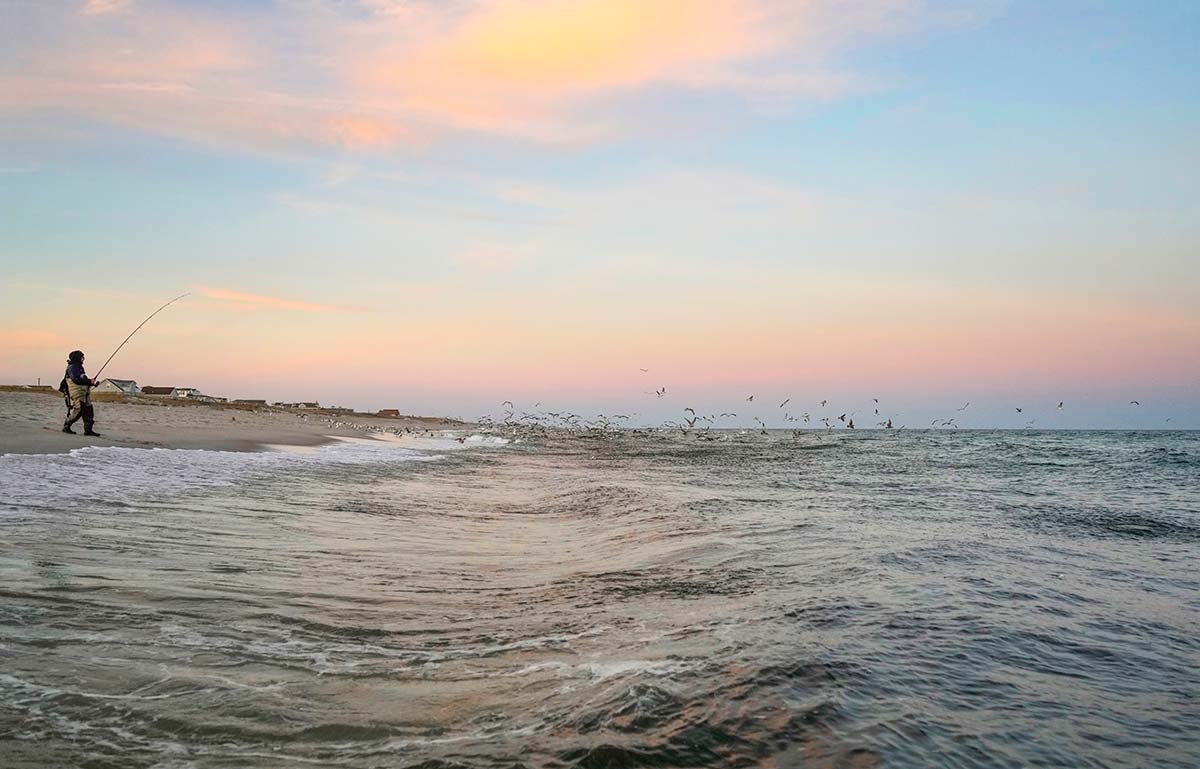
Fortune favors the bold in tactical flexibility this month.
With cell phones, internet, doom-broadcasts on the news, and the regular life grind, it’s been speculated our attention spans are shorter than those of generations ago. Even still, anglers would be hard pressed to forget how jaw-dropping the fall run was last year. I have been ardently striper fishing for 25 plus years now, and would have to agree.
Prior to the 2022 season, the gold standard, 10 out of 10 fall season with which to compare all others was the sand eel raid of 2011. That season the sand eels glued the bass – mostly up into the lower 20-pound range – into the surf for almost two months. The fish also remained in their areas for longer due to the unique borrowing behavior of this particular baitfish.
During the sand eel blitzes prior, needlefish, metals, and sinking lures of long, thin profile seemed to rope the bass throughout the day, especially morning ebb tides out on sandbars. Using teasers, it was common to catch two bass at once on the same cast, for multiple anglers simultaneously. Tom Lynch’s iconic photo of Thanksgiving weekend on Island Beach State Park hanging at Grumpys Bait and Tackle in Seaside Heights (see Jim Hutchinson’s article on Island Beach State Park in this edition) illustrates the shoulder-to-shoulder, belly-to-back crowds that fall run drew. It was unexpected another season would rival it, let alone surpass it…
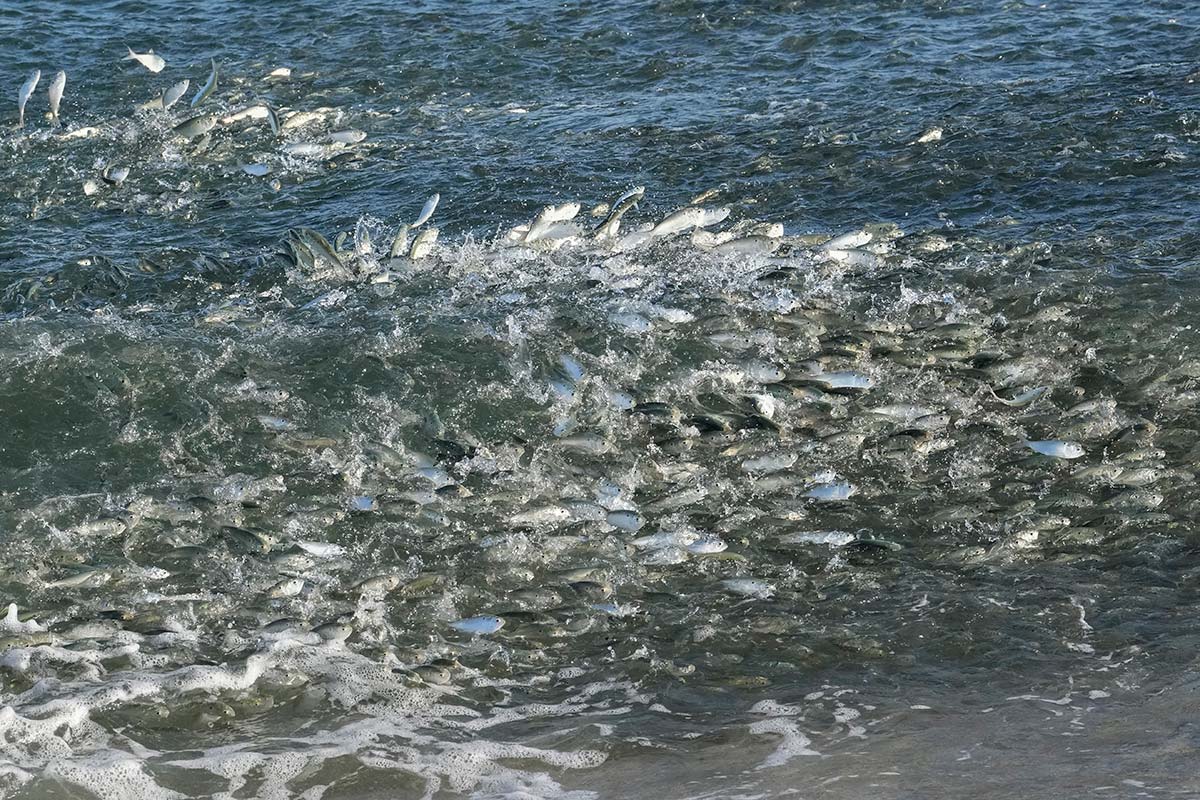
Flash forward to late September of 2022 as a large body of bass showed in Raritan Bay. At the month’s end and start of October, there was a hurricane that potentially threatened the development of a productive fall run to follow. However, the exact opposite happened in the calm that followed. Whether it was the body of fish pouring out of the bay and/or migrants coming inshore from the tip of Long Island, October 7 found 40-pounders invading Ocean and Monmouth beaches. They marauded hordes of adult bunker for several days as surfcasters beached them on swimmers, pencil poppers, and bunker chunks. Another short calm in fishing set in for a few days, but so too did a long calm period of weather punctuated by offshore winds from the west.
By the second week of October, Raritan was stacked again, potentially back-logged with stripers that didn’t seem to exist before the storm. These fish were of mixed size, some well into the 40-pound class, and were feeding heavily on an assortment of baitfish including adult bunker with anglers landing them on a variety of presentations. Then, like dominos, the boaters in Sandy Hook bay, the tip of Sandy Hook, and down along Sea Bright started going off with daytime blitzes.
At the end of October, endless amounts of what now were peanut and cupcake-size menhaden were coming down the beach. Unlike the sand eels that can hold to an area for long periods of time, bunker are more mobile, as are the bass bites they elicit. However, the temporal disadvantage of these bunker blitzes was overcompensated for by sheer volume of bait. Raritan Bay, Shark River, and Manasquan River were vomiting bunker for weeks and the heavenly weather over the next six weeks with sustained light westerlies gripped the bunker, and the thus the bass, along the beach! Yes, when it comes to bunker and surfcasting, west is indeed the best!
With adult bunker pods mixed in, blitzes of bass ranging in all sizes were caught in mass through Thanksgiving. Rivers of bait stretched 5 to 10 miles or more at times, and with water temps finally starting to drop in mid-December the spectacle finally started to wean. By both quantity and quality, personally and by others’ testimony, the fall run of 2022 dethroned that of 2011 for the pinnacle of fall runs (dare I use the word G.O.A.T. or greatest of all time).
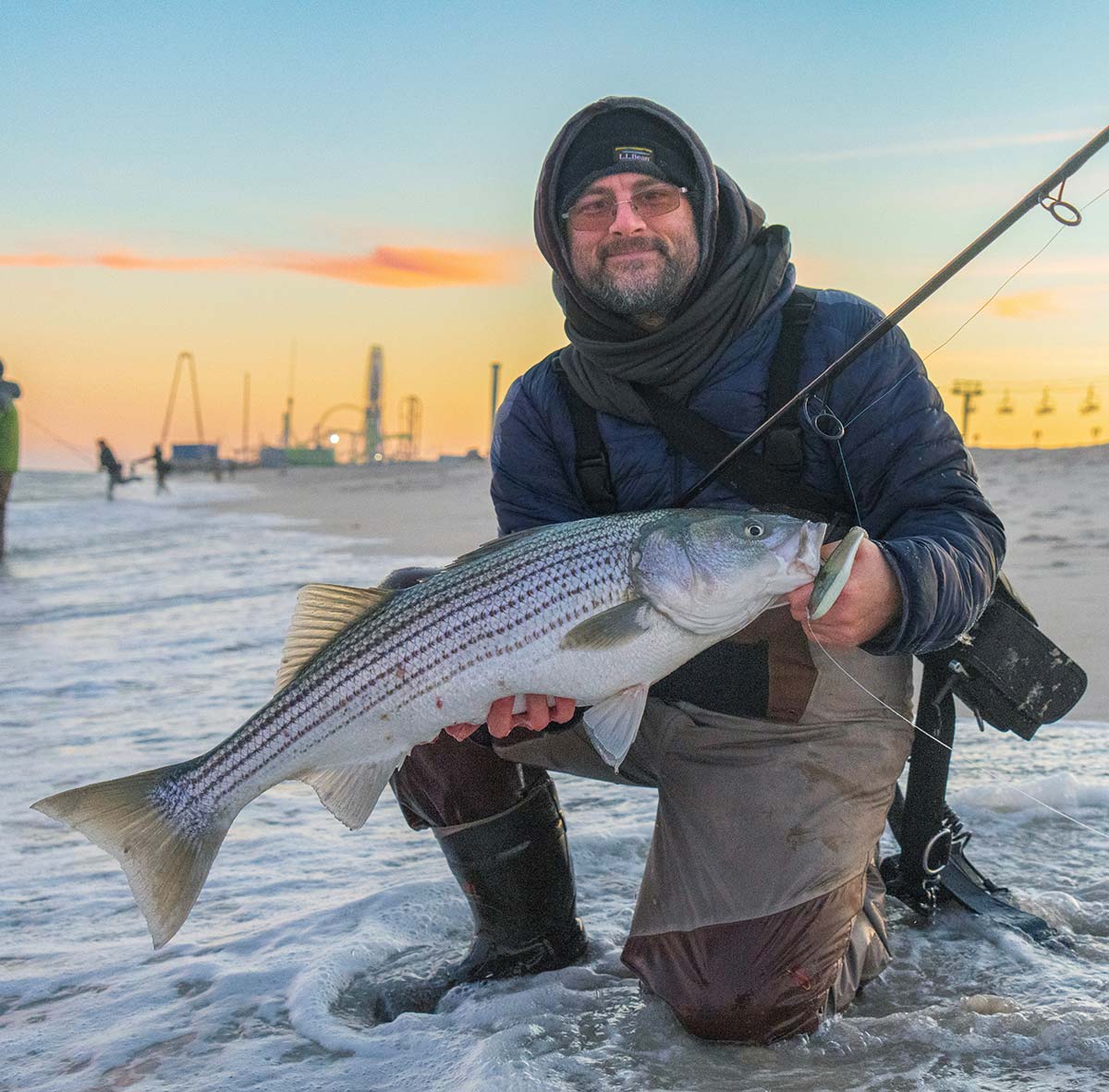
Timing, Mobility & Solitude
Even though the bass were unlimited last fall, so too were the crowds. Some surf situations created an uncomfortable, competitive atmosphere for space, especially on the rare occasion when the bite got tough. Even here, an angler can devise ways to lessen the impact surf crowds have on their catch ratios.
Whenever possible, take advantage of times when the beaches won’t be crowded. I, being eccentric as I am, decided last year to have Thanksgiving lunch instead of dinner. This allowed for the avoidance of beach-crowding and competition earlier in the day. That afternoon, while most were at home starting their food-comas, a National Geographic level peanut bunker blitz exploded in Seaside Heights. Only photographer Tom Lynch, two others, and I experienced the bliss that seemed to stretch from the Casino Pier to miles north.
On Turkey Day ’22, thousands of peanuts were beaching themselves in an attempt to escape the trough. They were pinned by stripers from outside and pressured by gulls above. As soon as any plug hit the water it was hooked up. This only intensified as the sky turned dusk-orange and the sun set. Regardless of the bites’ intensity though, each angler had more fish to catch per angler, no one impeding their casts, and no lines crossing without crowds around. The bonus of not having to witness many fish harvested and occasional tension among crowds added to the pristine situation to make it once in a life-time kind of experience.
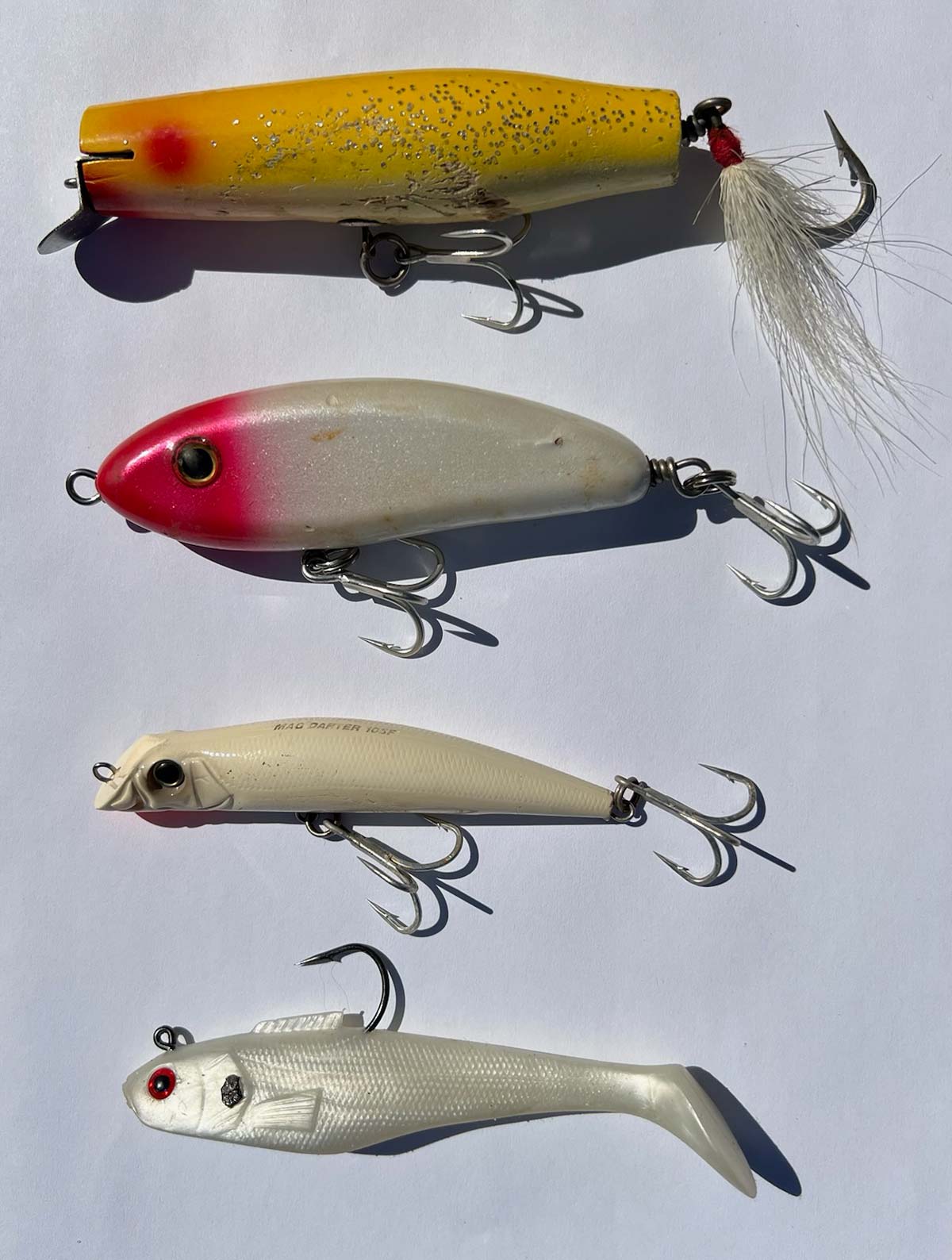
Sometimes there’s no way getting around the crowds. However, there are still some simple ways to get an edge over them. An obvious point is walking out to the sandbar if there is one on the beach being fished. The fishing was so extraordinary last fall that random people without waders were congesting the surf shoulder-to-shoulder. It was confusing to see regular, waded anglers continue to endure the congestion-frustration instead of simple walking out past the trough. Additionally, casting from the sandbar may make different size classes of bass accessible that otherwise weren’t from the beach lip.
If the blitzing bait pods span long enough, get ahead of them. Being mobile and trying to stay at the leading edge of a giant moving blitz helps decrease the time at the center of crowding. It can also give you first any indications of movement or behavioral changes in the body of fish before the other anglers. This way you can respond properly sooner than they can. Staying at the leading edge of the blitz relates to another point: being the first on site.
The first responders to blitzes usually get the most fish due to the extra time and less competition they experience. There is no use in this old school surfcaster complaining about cell phone communication and the internet. In fact, for blitzes at least, that should be embraced. They are transient, temporary situations anyway, very unlike spatial spots that get burned. That said, there is another great tool though that does not require establishing a trusted network or perpetually surveying the social media posts to help be an early blitz responder. This is of course the free online live Surf Cams (try thesurfersview.com). Most only miles apart from each other, continuously stream the visual water conditions along the entire Jersey Shore. I have been an early responder to many blitzes because of these little gadgets.
Into The Blitz
In these blitzes the bait can sometimes get excessively thick. Lures with trebles will enviably snag baitfish upon the retrieve, hindering the motion and profile of the plug. This will not only waste the cast that was just made, but also sap critical time when removing the peanuts off the hooks. Remember, the more time your presentation is in the water the more fish you’ll catch, that’s just simple statistics (provided you’re not doing anything detrimental in tactics).
There are also ways around the extra bait issue; casting beside or beyond the bait pod is the first fix. This should be done anyway as larger fish often hang on the outskirts. Reeling slowly has both a fish-attracting effect and lowers the chases of getting bait-kabobs. At the end of your cast, before your plug hits the water, stop the outgoing line with your finger. This slows or stops the plug from rapidly plunging into tightly packed baitfish, skewering them.
When the bait is thick, consider using plugs with only one treble, or replace the trebles with similar sized single hooks. This decreases bait snagging and time used to remove any impaled baitfish. Don’t neglect the beach lip or last few feet of retrieve. Bass can be following your offering all the way till the end where they may perceive it as cornered against the water’s edge.
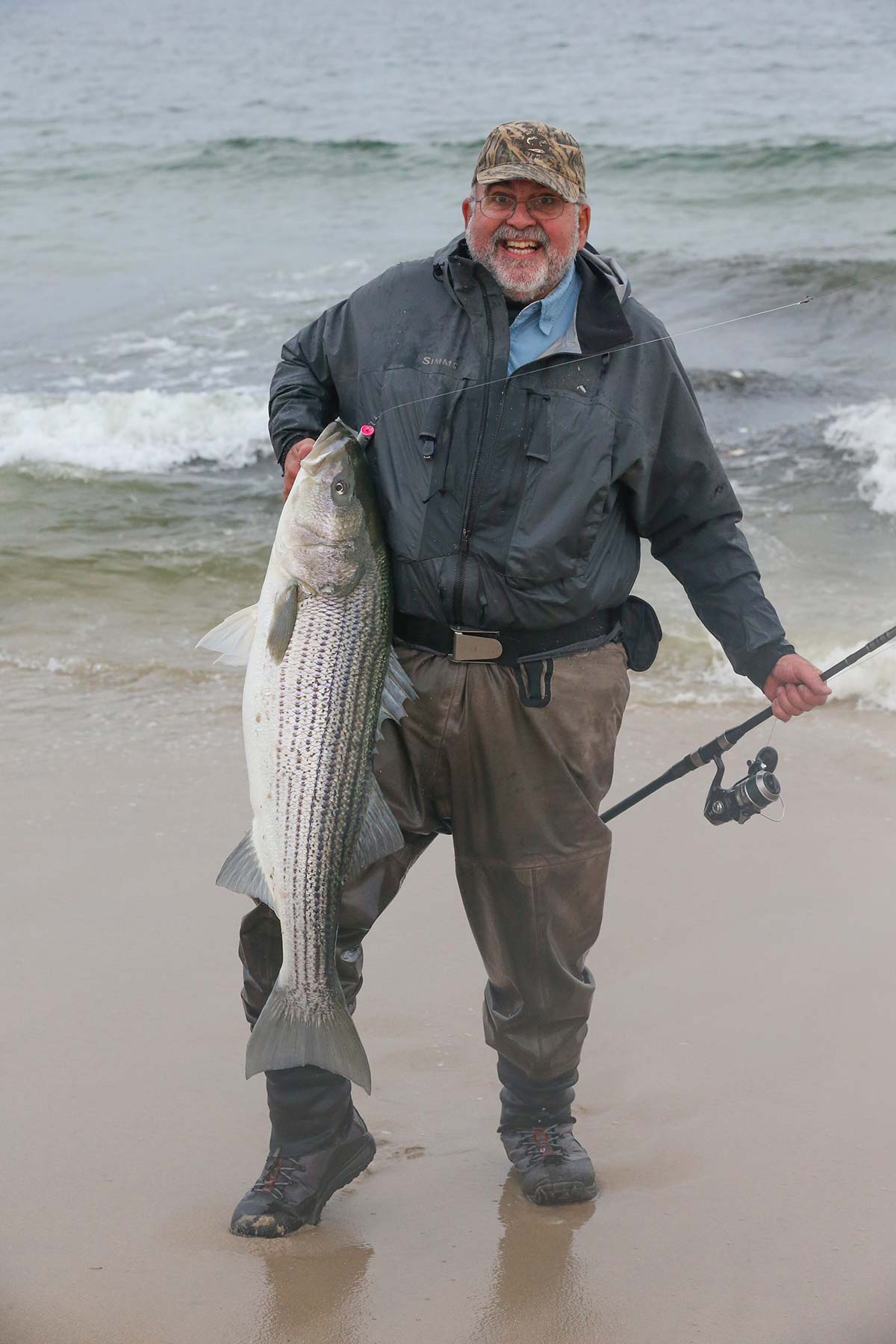
Last fall, the go-to lures were small swimmers, rubber shads, and gliders. Yellow or white seemed to match-the hatch the best. The MVP of the fall run of 2022 was definitely the white 5- and 6-inch Tsunami swim shad. Even on the rare days when stripers were extremely picky, this lure would still produce if worked very slowly along the bottom. These helped my former students, Joe Mitchell and Grant Johnson, outfish me on such days.
Sometimes the blitz is extra active, but all the fish being landed are of the same size class. If your goal is to get larger fish, sacrifice the optimal strategy for the prior size bass and change it up. This tactical experimentation can have large rewards. During the Thanksgiving Day blitz I was bailing teen-sized bass on rubber shads and yellow swimmers towards the end of the trough. Legendary surf photographer Tom Lynch on the other hand was content with the numbers he’d already caught, changing over to a 4-inch white Mag Darter for a solid 29-pounder near the beach lip. That specific plug has always been my favorite for small fish, but after that day I won’t discount it for trophies.
For that Thanksgiving blitz – and all the other epic bites that occurred along Ocean and Monmouth county beaches last fall – I am endlessly grateful. Let’s hope this fall run is just as epic!



